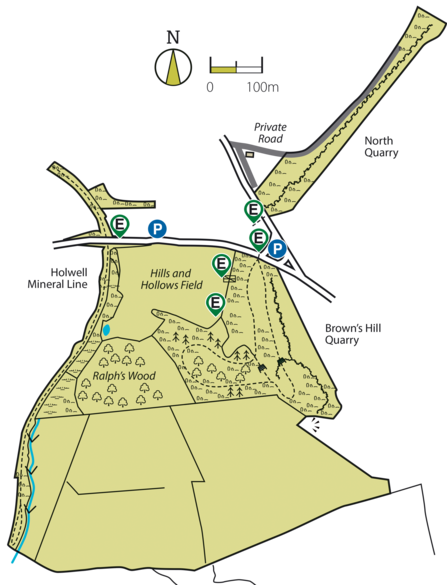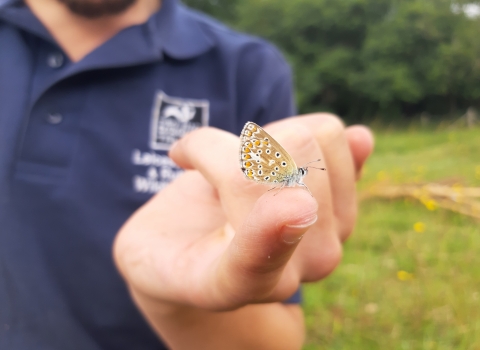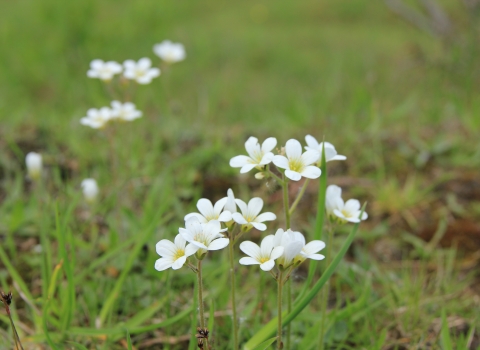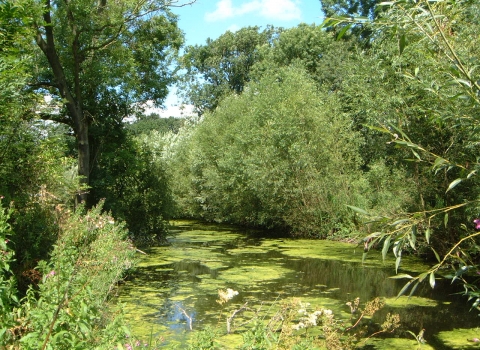
(c) Tony Clarke
Location
Know before you go
Dogs
When to visit
Opening times
Always openBest time to visit
SummerAbout the reserve
|
This trio of reserves together form a hidden gem in the Leicestershire countryside, just a few miles from Melton Mowbray and on the edge of the Vale of Belvoir. With a mosaic of habitats and steeped in geology and history, you can easily spend a few hours exploring the varied habitats and spotting the wildlife that lives there. There are steps and some slopes so come with good footwear. Originally a quarry, the reserves are built on the mines and the infrastructure that supported them. Dramatic bare rock faces, slopes and spoil heaps have now been colonised by herb-rich grassland. These hollows make ideal sheltered sun-traps, perfect for spotting butterflies in the spring and summer. Common blue, dingy skipper, green hairstreak, Essex skipper and more are all at home here. You’ll also have a chance of admiring common spotted-orchids, and even spotting a bee orchid or two. In the early spring, areas of the reserves that turn white with snowdrops. You’ll also be in with a chance of spotting some lovely woodland birds, which make the most of the feeders. Bird screens are set up at various points to give you the best views. Tits, finches, woodpeckers, sparrows and more all pay regular visits, and if you’re lucky you might even see a marsh tit. Willow warblers, blackcaps, lesser whitethroat and spotted flycatchers all nest here in late spring. Green woodpeckers make the most of the grasslands, you’ll be able to hear them yaffling around the whole area. Buzzards, kestrels and red kites have all been seen soaring overhead. The entrance to old mine tunnels can be seen on the reserve. The constant temperatures and fissured rocks of the tunnels provide ideal conditions for bats. Natterer’s, Daubenton’s, brown long-eared and pipistrelle bats have all been recorded. Quarrying has left shallow, lime-rich soils providing ideal conditions for many species of wildflower including St. Johns-wort, meadow vetchling, viper’s-bugloss and hare’s-foot clover. The rich herb layer includes ragged-robin, marsh thistle and common toadflax. In all 142 plant species have been recorded from the reserve. 95 different species of moth have been recorded as well as several species of dragonfly, including the large red and common blue damsels, and the brown hawker and ruddy darter. In 2020, we expanded the reserve by 14 hectares and in the winter of 2023-34 used just over 6 hectares of this new land to create Holwell Wood. Formerly improved arable grassland, the planted space now connects the established woodland within the reserve to an existing woodland just south of the reserve, creating a corridor to enable wildlife to move more freely through the landscape. The new wood was planted by volunteers, staff and trustees, local people from Holwell and other surrounding villages, children from a local nursery, corporate groups from Melton Mowbray and a local family from Ab Kettleby (made up of four generations!) who also very kindly donated further funding towards tree planting. We planted over 13,000 trees: a mixture of native species including hawthorn, Scots pine, hornbeam, holly, wild cherry and pedunculate oak. Generous funding came initially from The David Cock Foundation. David Cock (1914-1992) was a farmer, a very fine cricketer, a community-minded man and a philanthropist. He played cricket for Essex and served during the war in the Royal Air Force. He left over £6m in his will to be donated to good causes; Leicestershire and Rutland Wildlife Trust’s biggest tree planting project to date, at Holwell, was awarded some of that money. Further funds secured through the English Woodland Creation Offer (EWCO) managed by the Forestry Commission enabled us to expand the project significantly and bring further abundance and biodiversity to this, already regionally important, nature reserve. All in all, the diversity of these reserves is truly outstanding, and worth a visit at any time of year. |
Species
Contact us
Environmental designation
Reserve Map




